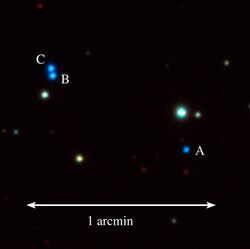Astronomy:J1953−1019
| Observation data {{#ifeq:2015.5|J2000.0 (ICRS)|Epoch J2000.0 Equinox J2000.0 (ICRS)| Epoch 2015.5 [[Astronomy:Equinox (celestial coordinates)|Equinox 2015.5}} | |
|---|---|
| Constellation | Aquila |
| J1953-1019 A | |
| Right ascension | 19h 53m 33.11s |
| Declination | −10° 19′ 55.10″ |
| Apparent magnitude (V) | 17.27 |
| J1953-1019 B | |
| Right ascension | 19h 53m 35.99s |
| Declination | −10° 19′ 31.76″ |
| Apparent magnitude (V) | 16.05 |
| J1953-1019 C | |
| Right ascension | 19h 53m 36.02s |
| Declination | −10° 19′ 29.49″ |
| Apparent magnitude (V) | 16.29 |
| Characteristics | |
| J1953-1019 A | |
| Evolutionary stage | White dwarf |
| Spectral type | DA |
| Apparent magnitude (G) | 17.28 |
| Apparent magnitude (B) | 17.27 |
| Apparent magnitude (R) | 17.30 |
| Apparent magnitude (g) | 17.18 |
| J1953-1019 B | |
| Evolutionary stage | White dwarf |
| Spectral type | DA |
| Apparent magnitude (G) | 16.35 |
| Apparent magnitude (B) | 16.05 |
| Apparent magnitude (R) | 16.30 |
| Apparent magnitude (g) | 16.15 |
| J1953-1019 C | |
| Evolutionary stage | White dwarf |
| Spectral type | DA |
| Apparent magnitude (G) | 16.44 |
| Apparent magnitude (B) | 16.29 |
| Apparent magnitude (R) | 16.44 |
| Apparent magnitude (g) | 16.24 |
| Astrometry | |
J1953-1019 A | |
| Proper motion (μ) | RA: −10.81 ± 0.25 mas/yr Dec.: −16.10 ± 0.15 mas/yr |
| Distance | 128.36 ± 2.40 pc |
J1953-1019 B | |
| Proper motion (μ) | RA: −11.54 ± 0.18 mas/yr Dec.: −16.33 ± 0.11 mas/yr |
| Distance | 130.37 ± 2.11 pc |
| J1953-1019 C | |
| Proper motion (μ) | RA: −10.94 ± 0.19 mas/yr Dec.: −15.66 ± 0.12 mas/yr |
| Distance | 130.89 ± 2.01 pc |
| Details[1] | |
J1953-1019 A | |
| Mass | 0.63 ± 0.03 M☉ |
| Temperature | 13715 ± 310 K |
| J1953-1019 B | |
| Mass | 0.62 ± 0.03 M☉ |
| Temperature | 22223 ± 360 K |
| J1953-1019 C | |
| Mass | 0.60 ± 0.03 M☉ |
| Temperature | 22104 ± 350 K |
| Other designations | |
| J1953-1019 A: Gaia DR2 4190500054845023488 | |
| J1953-1019 B: Gaia DR2 4190499986125543168 | |
| J1953-1019 C: Gaia DR2 4190499986125543296 | |
| Database references | |
| J1953-1019 A | |
| SIMBAD | data |
| J1953-1019 B | |
| SIMBAD | data |
| J1953-1019 C | |
| SIMBAD | data |
J1953-1019 is a hierarchical triple system of white dwarfs located at about 130 parsecs (about 420 light years) from the Earth. This is the first triple system of white dwarfs to be resolved.[2][1] The three white dwarfs have an atmosphere of pure hydrogen and a mass of about 0.6 times that of the Sun.
The system consists of a central pair, J1953-1019 BC, and a distant companion, J1953-1019 A. J1953-1019 B and C correspond to the sources Gaia DR2 4190499986125543168[3] and 4190499986125543296[4] respectively. The white dwarfs of the central pair, J1953-1019 B and C, are separated 303.25 ± 0.01 astronomical units (AU) from each other while the distant companion, J1953-1019 A, orbits the barycenter, or center of mass, of the central binary at a distance of 6398.97 ± 0.09 AU.[1]
The cooling age found by M. Perpinyà-Vallès and his collaborators for the three white dwarfs is consistent, with an estimated value between 40 and 290 million years.[1] The three stars would each come from a star that had a mass between 1.6 and 2.6 times that of the Sun. A collision of the central pair due to Lidov-Kozai oscillations is unlikely as the system is dynamically stable.[1] However, if this collision occurred, it could produce a type Ia supernova below the Chandrasekhar mass.[1]
References
- ↑ 1.0 1.1 1.2 1.3 1.4 1.5 Perpinyà-Vallès, M.; Rebassa-Mansergas, A.; Gänsicke, B. T.; Toonen, S.; Hermes, J. J.; Gentile Fusillo, N. P.; Tremblay, P.-E. (19 November 2018). "Discovery of the first resolved triple white dwarf". Monthly Notices of the Royal Astronomical Society 483 (1): 901–907. doi:10.1093/mnras/sty3149. Bibcode: 2019MNRAS.483..901P.
- ↑ "A student at the UPC's Barcelona School of Telecommunications has discovered the first resolved triple white dwarf system ever reported". Universitat Politècnica de Catalunya. BarcelonaTech. https://www.upc.edu/en/press-room/news/a-student-at-the-upc-barcelona-school-of-telecommunications-has-discovered-the-first-resolved-triple-white-dwarf-system-ever-reported. Retrieved 7 May 2019.
- ↑ simbad.u-strasbg.fr
- ↑ simbad.u-strasbg.fr


